This story first appeared in UC Davis Magazine, Volume 29 · Number 4 · Summer 2012
At a UC Davis outpost in the Pacific Northwest, wildlife veterinarians work to heal an ocean.
By Alison Kent
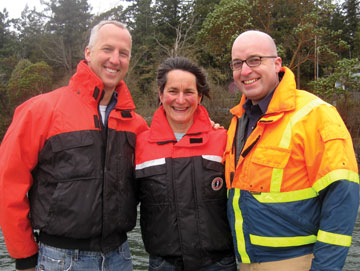 EASTSOUND, Wash. — "Watch out for the otter scat," warns UC Davis wildlife veterinarian Joe Gaydos, as he points to several tidy pink-crustacean-tinged piles on a dock. A glance over the edge of the dock reveals a world of anemones and algae swaying in the incoming tide. And overhead, a pair of courting bald eagles circles above the cedars in a gray February sky.
EASTSOUND, Wash. — "Watch out for the otter scat," warns UC Davis wildlife veterinarian Joe Gaydos, as he points to several tidy pink-crustacean-tinged piles on a dock. A glance over the edge of the dock reveals a world of anemones and algae swaying in the incoming tide. And overhead, a pair of courting bald eagles circles above the cedars in a gray February sky.
These stunning views — on shore, under water and in the air — offer glimpses of the expansive "laboratory" of the SeaDoc Society, an outpost of the UC Davis Wildlife Health Center on Orcas Island, the largest of Washington state's San Juan Islands. Through science and education, SeaDoc is working to protect the health of marine wildlife and their ecosystems 700 miles north of Davis in the Salish Sea. One of the world's largest inland seas, it covers more than 10,500 square miles, encompassing Washington's Puget Sound, the Strait of Juan de Fuca and the San Juan Islands, as well as British Columbia's Gulf Islands and the Strait of Georgia.
"The Salish Sea is one of the most amazing places on Earth and people who live here want to pass on a healthy ecosystem to future generations," says Gaydos. "SeaDoc's work is to make sure there will still be amazing wildlife, abundant fish and shellfish to eat and clean water for people and for wildlife far into the future."
The waters and shores of the Salish Sea are the shared home of 37 species of mammals, 172 species of birds, 247 species of fish, more than 3,000 species of invertebrates and nearly 6 million people. This lush ecosystem includes killer whales, bald eagles, Pacific salmon, abalone, crabs and clams. Indeed, the species count is one example of SeaDoc's work here — a report that Gaydos co-authored in 2011 included the first compilation of birds and mammals that depend on the Salish Sea.
But a growing number of those species are in decline — another SeaDoc finding. Since 2002, SeaDoc has tracked the overall number of wildlife species that are listed as threatened or endangered in the Salish Sea; from 2008 to 2011, that number nearly doubled, from 64 to 113.
A powerful partnership
How and why the UC Davis Wildlife Health Center established the SeaDoc Society so far from campus is a testament to the center's reputation as well as a local couple's commitment to restoring the health of the Salish Sea.
In the late 1990s, philanthropists Ron and Kathy McDowell of the San Juan Islands began looking for an institutional partner with the right credentials — high-caliber academics and a good history of working on ecosystem-level problems — to study and enhance the health of the Salish Sea. Impressed with the School of Veterinary Medicine's talented faculty and its Wildlife Health Center's applied, problem-solving approach to conservation and health, the McDowells considered the school a perfect partner for developing a new program — one that would apply the veterinarian's patient-oriented skills, not on individual animals, but on the whole ecosystem.
Then-Dean Bennie Osburn reasoned that if the veterinary school could run programs in Africa, it certainly could run one in Washington state. Osburn tapped the Wildlife Health Center for the program. Veterinarian Kirsten Gilardi was named director; Gaydos, a veterinarian specializing in medical microbiology and wildlife diseases then working at the University of Georgia, was brought on as regional director and chief scientist.
Gilardi and Gaydos quickly established what today has evolved into a unique marine ecosystem health program — one that combines new research into critical questions about the management of the Salish Sea, science translation that ensures that the information is getting into the hands of policymakers and the public, and the close involvement of citizens providing input and support. The SeaDoc Society recently celebrated its 10th birthday, and in this short time has become a key player in marine conservation in the Salish Sea.
"To me, the most interesting thing about SeaDoc is the fact that it's a private/public partnership," says Gary Davis, chair of SeaDoc's board of directors and a former senior scientist with the National Park Service. "It's a small group of citizens interested in collectively doing something to improve the environment. It's a powerful combination when supported by an institution like the University of California, particularly the Wildlife Health Center and the School of Veterinary Medicine. It means you can do things in a different way."
With just five employees at the Orcas Island headquarters, and a shoestring annual budget of about $500,000, SeaDoc depends on citizens' involvement, Gilardi says. "SeaDoc is largely funded by private gifts and most of our donors are local, so they feel incredibly connected to — and partly and rightfully responsible for — the success of SeaDoc's work in the Salish Sea," she says. "It's what makes SeaDoc unique: the university working hand-in-hand with concerned citizens to get essential science done that conserves wildlife and helps to heal the ocean."
One Sea, One Health
Even the name of the Salish Sea reflects the work of the SeaDoc Society. Formerly known as Puget Sound and Georgia Basin, the inland sea was renamed by the U.S. and Canada in 2010 in honor of the Coast Salish, the people who have inhabited the region for millennia.
"SeaDoc really pushed for adopting the new name 'Salish Sea' because it drives home the concept that this is a whole ecosystem, regardless of political boundaries," says Gaydos.
Since international borders are invisible to fish and other wildlife, the SeaDoc Society recognized that healing Washington's inland waters was going to require an approach that "treated" the inland waters as a whole entity, rather than as a sum of parts, much as a veterinarian approaches an individual patient.
This holistic view of the marine region, and the people and animals that live in it in a connected interdependence, is in keeping with the Wildlife Health Center's focus on One Health, a philosophy that recognizes that the health of the environment is essential for the health of wildlife, domestic animals and people — and vice versa.
Informing policy
SeaDoc's success in translating science is evident in the growing number of policymakers who seek its help. Groups like the Northwest Indian Fisheries Commission, the Washington governor's office, Washington State Legislature and the Washington Department of Fish and Wildlife regularly ask SeaDoc to provide the current state of science on a particular issue so that a sound management or policy decision can be made.
As Gaydos says, "Science is great because it gives us the facts that help us make good decisions and inspire people to want to care — to want to save a place."
For more than eight years, SeaDoc has hosted a winter lecture series. Gaydos, who was hired as a translational scientist, gives an average of two professional presentations a month. He also sits on a number of science panels, including the Puget Sound Partnership Science Panel, which is charged with restoring Puget Sound by 2020. Martha Kongsgaard, chair of the Puget Sound Partnership, says "SeaDoc plays a unique role in not only producing essential science, but, as importantly, in integrating that science into environmental policy."
Gaydos and his collaborators conduct research on how disease impacts wildlife populations. In addition, using privately donated funds, SeaDoc awards competitive grants to scientists to focus on the marine ecosystem or on the threatened and endangered species that live in it. Those species include the following:
 River otters Those telltale signs of otters on the dock provide evidence for a scientific study on how the predators, which eat up to 15–20 percent of their body weight in food every day, could affect salmon and rockfish populations.
River otters Those telltale signs of otters on the dock provide evidence for a scientific study on how the predators, which eat up to 15–20 percent of their body weight in food every day, could affect salmon and rockfish populations.
Northern (pinto) abalone A number of funded studies looked at why the population of this native mollusk had not recovered, but rather declined, since Washington and British Columbia banned their recreational harvest in the 1990s. One project examined genetics, another looked at hatchery release techniques, a third studied interactions of pinto abalone with other species, and a fourth explored whether aggregating animals left in the wild helps them breed.
The results: the discovery of a subspecies that improved hatchery breeding, and a finding that hatchery young are less likely to become merely crab bait if placing in the sea is delayed until they grow to about 1 inch in diameter. These and other scientific discoveries formed the foundation for what is now an active statewide recovery program.
Western grebe A bird so aquatic that it can't even walk on land and builds floating nests, the Western grebe has declined by 95 percent over the past several decades in the Salish Sea. Although once there were flocks of 3,000 to 5,000 in Bellingham Bay, Gaydos and his colleagues now get excited when they see 50. Gaydos and collaborators have improved a surgical procedure to allow scientists to implant transmitters in these birds to track their migratory patterns and better understand their decline.
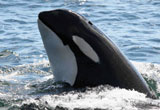 Killer whales Three distinct types of killer whales, or orcas (Orcinus orca), live in the Salish Sea. The most commonly encountered are the fish-eating "resident" orcas. These whales are salmon eaters, preferring Chinook, as shown in recent studies. Less commonly seen are the marine mammal-eating "transient" killer whales. Occasionally, "offshore" killer whales are spotted in the Salish Sea and are thought to be fish and shark-eaters. All three ecotypes of killer whales are state and federally listed as endangered.
Killer whales Three distinct types of killer whales, or orcas (Orcinus orca), live in the Salish Sea. The most commonly encountered are the fish-eating "resident" orcas. These whales are salmon eaters, preferring Chinook, as shown in recent studies. Less commonly seen are the marine mammal-eating "transient" killer whales. Occasionally, "offshore" killer whales are spotted in the Salish Sea and are thought to be fish and shark-eaters. All three ecotypes of killer whales are state and federally listed as endangered.
Killer whales from the Salish Sea are some of the most contaminated marine mammals in the world, and pollutants are considered a factor in causing the decline of the southern resident population. The Salish Sea has very high levels of legacy PCBs, chemicals once widely used in manufacturing electrical equipment and a variety other products. SeaDoc has ensured critical research to look at contaminants in salmon and how they affect the killer whales that eat them. SeaDoc has also conducted research examining the role of disease in the declining killer whale population.
On the other hand, one species that is doing well is the harbor seal, and its story is a testament to what can be done when species-appropriate action is taken. In 1972, following studies that had shown a precipitous decline in the harbor seal population, the U.S. passed the Marine Mammal Protection Act, which has enabled the Salish Sea's population of harbor seals to bounce back and stabilize, from about 2,000 to around 12,000 animals. The Salish Sea population is now one of the most dense harbor seal populations found anywhere in the world. Stories like this can move the public to advocate for measures that will give other species a chance.
Far-reaching impacts
SeaDoc's ability to assess the ocean's ills, diagnose ecosystem health ailments and propose solutions or cures for them has resonated well beyond the Salish Sea. The group also sponsors research along the California and Baja California coasts and coordinates a West Coast program to clean up derelict fishing gear, which kills marine life.
That's not to say there aren't frustrations for the SeaDoc team. "Sometimes it does get hard. You get frustrated that recovery isn't moving fast enough or worried that we're not raising more money," Gaydos says, "because we know the amount of work that still has to be done.
"But one good part of my job is that I get to see all the good work that is happening — on salmon and killer whale recovery, on restoring estuaries. So, we're making progress, and a lot of people really do recognize the importance of SeaDoc's work. That's hugely gratifying."
Alison Kent is publications coordinator for the Wildlife Health Center.
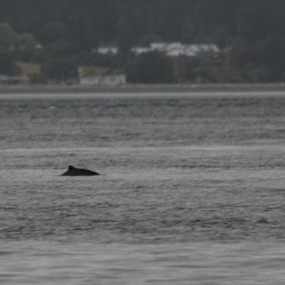 Although the harbor porpoise is the most abundant and widely dispersed cetacean species in the Salish Sea, we still know very little about its habitat needs, distribution, population trends, life cycle, genetics, behavior and role in the ecosystem.
Harbor porpoises feed primarily on fish and are among the smallest of the cetaceans, reaching an average size of about 5 feet and 120 pounds. They can dive deep, more than 655 feet, but usually stay near the surface, coming up regularly to breathe with a distinctive puffing noise that resembles a sneeze.
Although the harbor porpoise is the most abundant and widely dispersed cetacean species in the Salish Sea, we still know very little about its habitat needs, distribution, population trends, life cycle, genetics, behavior and role in the ecosystem.
Harbor porpoises feed primarily on fish and are among the smallest of the cetaceans, reaching an average size of about 5 feet and 120 pounds. They can dive deep, more than 655 feet, but usually stay near the surface, coming up regularly to breathe with a distinctive puffing noise that resembles a sneeze.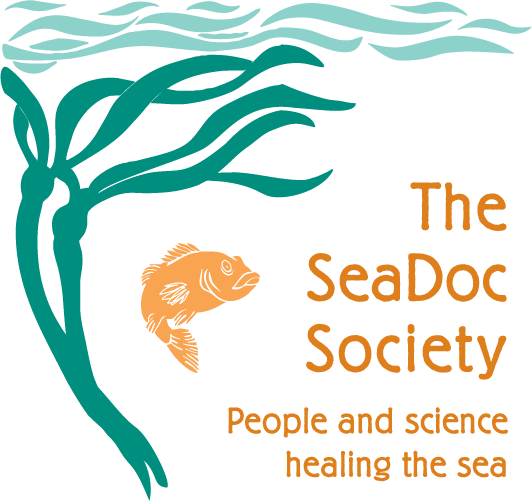





 EASTSOUND, Wash. — "Watch out for the otter scat," warns UC Davis wildlife veterinarian Joe Gaydos, as he points to several tidy pink-crustacean-tinged piles on a dock. A glance over the edge of the dock reveals a world of anemones and algae swaying in the incoming tide. And overhead, a pair of courting bald eagles circles above the cedars in a gray February sky.
EASTSOUND, Wash. — "Watch out for the otter scat," warns UC Davis wildlife veterinarian Joe Gaydos, as he points to several tidy pink-crustacean-tinged piles on a dock. A glance over the edge of the dock reveals a world of anemones and algae swaying in the incoming tide. And overhead, a pair of courting bald eagles circles above the cedars in a gray February sky. River otters Those telltale signs of otters on the dock provide evidence for a scientific study on how the predators, which eat up to 15–20 percent of their body weight in food every day, could affect salmon and rockfish populations.
River otters Those telltale signs of otters on the dock provide evidence for a scientific study on how the predators, which eat up to 15–20 percent of their body weight in food every day, could affect salmon and rockfish populations. Killer whales Three distinct types of killer whales, or orcas (Orcinus orca), live in the Salish Sea. The most commonly encountered are the fish-eating "resident" orcas. These whales are salmon eaters, preferring Chinook, as shown in recent studies. Less commonly seen are the marine mammal-eating "transient" killer whales. Occasionally, "offshore" killer whales are spotted in the Salish Sea and are thought to be fish and shark-eaters. All three ecotypes of killer whales are state and federally listed as endangered.
Killer whales Three distinct types of killer whales, or orcas (Orcinus orca), live in the Salish Sea. The most commonly encountered are the fish-eating "resident" orcas. These whales are salmon eaters, preferring Chinook, as shown in recent studies. Less commonly seen are the marine mammal-eating "transient" killer whales. Occasionally, "offshore" killer whales are spotted in the Salish Sea and are thought to be fish and shark-eaters. All three ecotypes of killer whales are state and federally listed as endangered.

 Dioxins and furans are highly toxic persistent organic pollutants that once were dumped into the Salish Sea in pulp mill effluent. They are counted among the twelve most poisonous “dirty dozen” toxins in the world, and once were concentrated in fish and fish-eating birds in British Columbia, causing fishery closures and waterfowl consumption advisories. Thanks to mandated changes in bleaching processes and restrictions on usage of the parent compounds for these toxic chemicals at pulp mills, discharge of dioxins and furans into the Salish Sea has been eliminated.
Dioxins and furans are highly toxic persistent organic pollutants that once were dumped into the Salish Sea in pulp mill effluent. They are counted among the twelve most poisonous “dirty dozen” toxins in the world, and once were concentrated in fish and fish-eating birds in British Columbia, causing fishery closures and waterfowl consumption advisories. Thanks to mandated changes in bleaching processes and restrictions on usage of the parent compounds for these toxic chemicals at pulp mills, discharge of dioxins and furans into the Salish Sea has been eliminated. Dr. Elliot began his work in the mid-1980s with research on great blue herons, to better understand the possible effects of persistent organic pollutants on these aquatic birds. As part of a team that included population biologists, chemists and biochemists, Elliot documented for the first time the exposure of wild birds to the forest industry derived pollutants, dioxins and furans. As well, he documented high concentrations of these chemicals in bald eagles living near pulp mill sites, and went on to determine the deleterious effects of these toxins on eagles breeding near contaminated areas. His initial studies led to further research demonstrating the effects of these chemicals on embryonic development of both herons and cormorants at colonies near pulp mills and other forest industry sites in the Salish Sea.
Dr. Elliot began his work in the mid-1980s with research on great blue herons, to better understand the possible effects of persistent organic pollutants on these aquatic birds. As part of a team that included population biologists, chemists and biochemists, Elliot documented for the first time the exposure of wild birds to the forest industry derived pollutants, dioxins and furans. As well, he documented high concentrations of these chemicals in bald eagles living near pulp mill sites, and went on to determine the deleterious effects of these toxins on eagles breeding near contaminated areas. His initial studies led to further research demonstrating the effects of these chemicals on embryonic development of both herons and cormorants at colonies near pulp mills and other forest industry sites in the Salish Sea.
 There are 28 species of rockfish in the Salish Sea. Thirteen (13) are listed as species of concern and recently 3 species were listed under the US Endangered Species Act.
There are 28 species of rockfish in the Salish Sea. Thirteen (13) are listed as species of concern and recently 3 species were listed under the US Endangered Species Act.
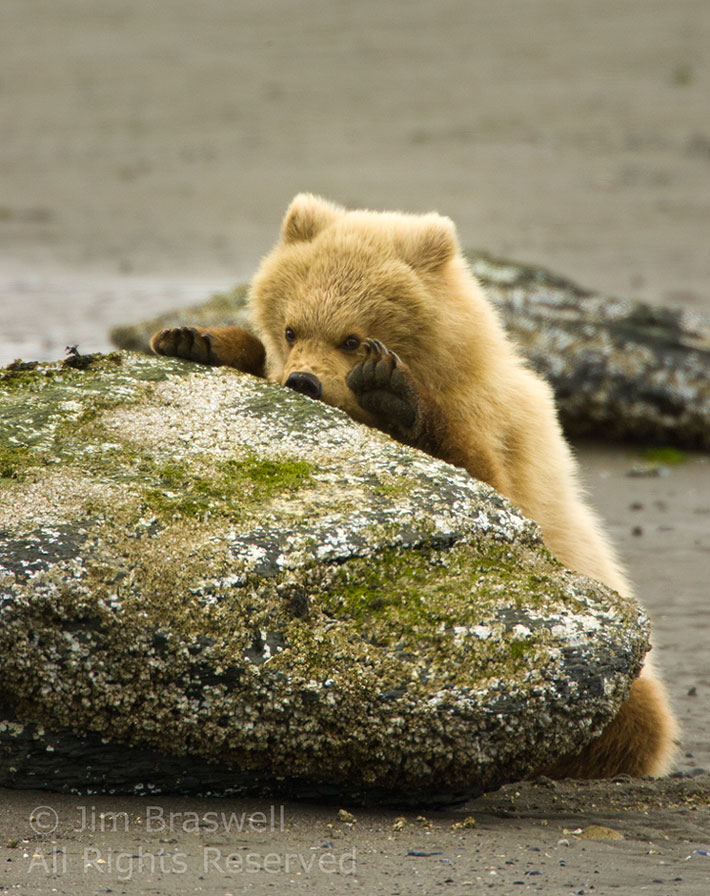
 We've created a printable checklist of all the bird and mammal species that depend on the Salish Sea.
We've created a printable checklist of all the bird and mammal species that depend on the Salish Sea.



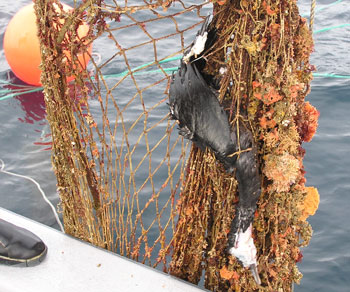
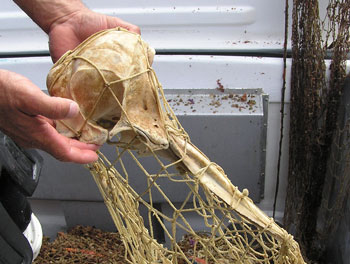 SeaDoc works on derelict fishing gear in California and in the Salish Sea.
SeaDoc works on derelict fishing gear in California and in the Salish Sea.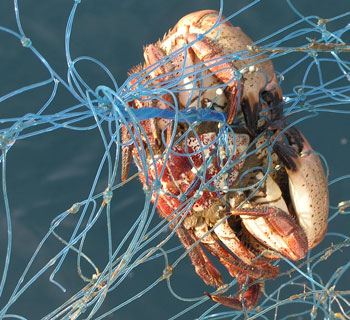 Salish Sea
Salish Sea